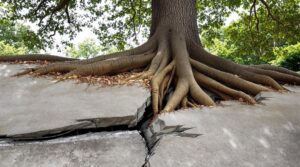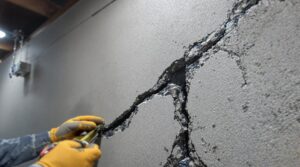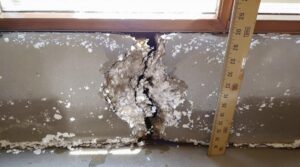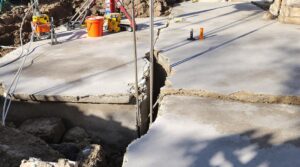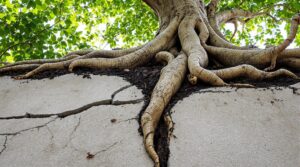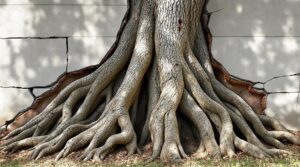Magnolia tree roots can potentially damage house foundations due to their extensive growth patterns. The root system expands outward, with mature systems spreading 2-3 times the canopy diameter. This growth can exert pressure on surrounding soil and structures, including foundations, causing damage such as cracks and displacement. The severity of damage depends on factors like soil moisture and composition. Exploring the intricacies of magnolia tree root growth and their interactions with surrounding structures reveals more about prevention and mitigation strategies.
Key Takeaways
- Magnolia tree roots can cause damage to house foundations through root expansion and pressure on surrounding soil and structures.
- Root systems can spread 2-3 times the tree's canopy diameter, posing a significant risk to nearby foundations.
- Soil moisture and composition can influence root growth and expansion, affecting the likelihood of foundation damage.
- Signs of foundation damage from magnolia tree roots include cracks, unevenness, and sticking doors and windows.
- Planting trees at least 15-20 feet away from foundations and conducting regular maintenance can help prevent foundation damage.
How Do Magnolia Tree Roots Grow?
Because the magnolia tree's root system plays an essential role in its overall health and structural integrity, understanding its growth patterns is important for effective tree management.
The root structure of a magnolia tree consists of a taproot and a network of lateral roots that spread out from the base of the trunk. As the tree grows, the taproot deepens, and the lateral roots expand outward, often forming a shallow but extensive root system.
The growth patterns of magnolia tree roots are characterized by an initial rapid growth phase, followed by a slower, more steady expansion. In mature trees, the root system can spread out over a large area, often two to three times the diameter of the tree's canopy.
Understanding these growth patterns is essential for determining the tree's potential impact on surrounding structures, such as house foundations. The root structure and growth patterns of magnolia trees are significant factors in tree management.
Factors That Influence Magnolia Tree Root Growth
While the root structure and growth patterns of magnolia trees are inherent characteristics of the species, various environmental and external factors can greatly influence the growth and development of their roots.
One key factor is soil moisture, as magnolia tree roots tend to grow more extensively in search of water in areas with low soil moisture. In regions with high soil moisture, the roots may grow less extensively, as they can obtain sufficient water with less effort.
Additionally, root depth is influenced by factors such as soil composition and aeration. For example, in areas with well-draining, loose soils, magnolia tree roots are likely to grow deeper, while in areas with dense, poorly draining soils, the roots may grow more shallowly.
These factors can impact the overall size and distribution of the root system, which in turn can influence the tree's ability to support itself and absorb nutrients.
Types of Damage Magnolia Tree Roots Can Cause
Numerous studies have documented the potential of magnolia tree roots to cause significant damage to house foundations, sidewalks, and other structural elements.
One primary type of damage is caused by root expansion, where the growing roots exert pressure on surrounding soil and structures, leading to cracks and displacement. As the roots continue to grow, they can also cause soil erosion, particularly in areas with loose or unstable soil.
This erosion can lead to soil settling or shifting, which can further compromise the integrity of nearby foundations. Additionally, magnolia tree roots can infiltrate and clog drainage systems, leading to water accumulation and potential flooding.
In some cases, the roots can also grow into and damage pipes, causing leaks and other plumbing issues. Understanding these potential damage types is essential for homeowners to take preventative measures and mitigate potential risks associated with magnolia tree root growth.
Signs of Foundation Damage From Magnolia Tree Roots
Homeowners who have magnolia trees growing in close proximity to their house foundations should be aware of the signs of potential foundation damage caused by the tree's root system.
Cracks in walls, ceilings, and floors are common indicators of foundation damage. Doors and windows that stick or are difficult to open and close can also be a sign of foundation problems.
Foundation inspection can reveal more subtle signs of damage, such as unevenness or bowing of foundation walls. In severe cases, magnolia tree roots can cause foundation walls to collapse or shift, leading to costly repairs.
Regular monitoring of the tree's root system and foundation is essential to prevent extensive damage. Installation of root barriers can help prevent roots from growing too close to the foundation.
Homeowners should consult with a certified arborist or foundation specialist to assess the risk of foundation damage from magnolia tree roots.
Preventing and Mitigating Foundation Damage From Magnolia Trees
Employing proactive measures is vital in preventing and mitigating foundation damage caused by magnolia tree roots. Effective root system management and adherence to tree placement guidelines can greatly minimize the risk of damage.
When planting a magnolia tree, choosing a location at a safe distance from the house foundation is essential. A general rule of thumb is to plant the tree at least 15-20 feet away from the foundation.
Regular maintenance, such as pruning and root pruning, can also help control the growth of the root system.
Installing a root barrier, a physical or chemical barrier designed to redirect or restrict root growth, can be an effective measure in preventing damage.
Homeowners should also verify proper soil conditions and adequate moisture levels to promote healthy tree growth and prevent root system expansion.
Frequently Asked Questions
Can Magnolia Trees Be Safely Planted Near Septic Systems?
Magnolia trees can be safely planted near septic systems if proper spacing is observed. A general rule of thumb is to maintain a minimum distance of 20-30 feet between the tree and the septic system to minimize impact.
Are Some Magnolia Tree Varieties Safer for Foundations Than Others?
Like sprawling fingers, magnolia tree roots expand, influencing nearby structures. The extent of root growth varies by tree variety, with compact cultivars like 'Little Gem' or 'Genie' potentially posing less risk than larger, more vigorous varieties.
How Long Does It Take for Magnolia Tree Roots to Cause Damage?
The root growth timeline of magnolia trees varies, but generally, noticeable foundation impact can occur within 10-20 years after planting, with more significant damage possible after 30-50 years, depending on factors like soil type and tree size.
Can Magnolia Tree Roots Damage Neighbor's Property Foundations?
Investigations reveal that magnolia tree roots can potentially damage neighbor's property foundations through root encroachment, leading to costly repairs and neighbor disputes, especially if not addressed promptly or properly by property owners or local authorities.
Are Magnolia Tree Roots Covered by Homeowner's Insurance Policies?
Typically, homeowner's insurance policies do not cover damage caused by tree root growth. Root damage may be covered if it is a result of a named peril, but regular maintenance is generally not included.
